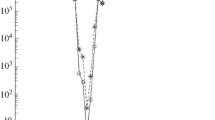Abstract
A change in the law of attraction in some regimes is predicted in the modified gravity models being actively developed at present. The set of up-to-date observational data leaves a wide range of admissible parameters for the theory. In this paper, we consider the possibility that the signal recorded by the Geograv resonant gravitational-wave detector in 1987 during the explosion of SN 1987A was produced by an abrupt change in the metric during the passage of a powerful neutrino flux through the detector. Such an impact on the detector is possible, in particular, in extended scalar–tensor theories in which the local matter density gradient affects the gravitational force. The first short neutrino pulse emitted at the initial stage of stellar core collapse before the onset of neutrino opacity could exert a major influence on the detector, because it could produce the detector response at the first resonance frequency. In contrast, the influence of the subsequent broad pulse (with a duration of several seconds) in the resonant detector is exponentially suppressed, despite the fact that the second pulse carries an order-of-magnitude more neutrino energy, and it could generate a signal in the LSD neutrino detector. This explains the time delay of 1.4 s between the Geograv and LSD signals. The consequences of this effect of modified gravity for future LIGO/Virgo observations are discussed.


Similar content being viewed by others
Notes
Note that in the original version of Horndeski’s theory [25] the second term in (6) is absent.
We are grateful to the referee of this paper who pointed to this possibility.
REFERENCES
J. Bahcall, Neutrino Astrophysics (Cambridge Univ. Press, Cambridge, 1989).
V. L. Dadykin, G. T. Zatsepin, V. B. Korchagin, et al., JETP Lett. 45, 593 (1987).
L. Stella and L. Treves, Astron. Astrophys. 185, L5 (1987).
W. Hillebrandt, P. Hoflich, and P. Kafka, Astron. Astrophys. 180, L20 (1987).
A. de Rujula, Phys. Lett. B 193, 514 (1987).
V. S. Berezinsky, C. Castagnoli, V. I. Dokuchaev, et al., Nuovo Cim. 11, 287 (1988).
V. L. Dadykin, G. T. Zatsepin, and O. G. Ryazhskaya, Sov. Phys. Usp. 32, 459 (1989).
V. S. Imshennik and D. K. Nadezhin, Usp. Fiz. Nauk 156, 561 (1988).
V. S. Imshennik and O. G. Ryazhskaya, Astron. Lett. 30, 14 (2004).
G. S. Bisnovatyi-Kogan, S. G. Moiseenko, and N. V. Ardelyan, Phys. At. Nucl. 81, 266 (2018).
F. Vissani, J. Phys. G: Nucl. Part. Phys. 42, 013001 (2015); arXiv:1409.4710 [astro-ph.HE].
B. P. Abbott, R. Abbott, T. D. Abbott, et al., Phys. Rev. Lett. 119, 161101 (2017); arXiv:1710.05832[gr-qc].
E. Amaldi, P. Bonifazi, M. G. Castellano, et al., Europhys. Lett. 3, 1325 (1987).
M. Aglietta, A. Castellina, W. Fulgione, et al., Nuovo Cim. C 14, 171 (1991).
Yu. V. Baryshev, Astrophysics 40, 244 (1997).
M. Crisostomi, K. Koyama, and G. Tasinato, J. Cosmol. Astropart. Phys. 04, 044 (2016); arXiv:1602.03119 [hep-th].
J. Ben Achour, D. Langlois, and K. Noui, Phys. Rev. D 93, 124005 (2016); arXiv:1602.08398 [gr-qc].
A. I. Vainshtein, Phys. Lett. B 39, 393 (1972).
E. Babichev and C. Deffayet, Class. Quantum Grav. 30, 184001 (2013); arXiv:1304.7240 [gr-qc].
A. V. Zasov and K. A. Postnov, General Astrophysics (Vek 2, Fryazino, 2016) [in Russian].
G. T. Zatsepin, JETP Lett. 8, 205 (1968).
D. S. Gorbunov and V. A. Rubakov, Introduction to the Early Universe Theory: The Hot Big Bang Theory (URSS, Moscow, 2016) [in Russian].
T. Kobayashi, Y. Watanabe, and D. Yamauchi, Phys. Rev. D 91, 064013 (2015); arXiv:1411.4130 [gr-q]c.
R. Saito, D. Yamauchi, S. Mizuno, et al., Astropart. Phys. 06, 008 (2015); arXiv:1503.01448 [gr-qc].
G. W. Horndeski, Int. J. Theor. Phys. 10, 363 (1974).
E. Amaldi and G. Pizzella, in Astrophysics, Quants and Theory of Relativity, Collection of Articles (Mir, Moscow, 1982), p. 241 [in Russian].
L. D. Landau and E. M. Lifshitz, Course of Theoretical Physics, Vol. 7: Theory of Elasticity (Nauka, Moscow, 1965; Pergamon Press, New York, 1986).
D. K. Nadezhin, Astrophys. Space Sci. 53, 131 (1978).
J. K. Becker, F. Halzen, A. O’Murchadha, et al., arXiv:1003.4710 [astro-ph.HE].
B. P. Abbott, R. Abbott, T. D. Abbott, et al., Astrophys. J. Lett. 848, L12 (2017); arXiv:1710.05833 [astro-ph.HE].
Funding
This research was supported by the CNRS/RFBRCooperation program for 2018–2020 no. 1985 (France), Russian Foundation for Basic Research (project no. 18-52-15001 CNRS) (Russia) “Modified gravity and black holes: noncontradictory models and exterimental manifestations,” and CNRS/INSU National program of cosmology and galaxies (France).
Author information
Authors and Affiliations
Corresponding authors
Additional information
Translated by V. Astakhov
Rights and permissions
About this article
Cite this article
Eroshenko, Y.N., Babichev, E.O., Dokuchaev, V.I. et al. Possible Explanation of the Geograv Detector Signal during the Explosion of SN 1987A in Modified Gravity Models. J. Exp. Theor. Phys. 128, 599–606 (2019). https://doi.org/10.1134/S1063776119030166
Received:
Revised:
Accepted:
Published:
Issue Date:
DOI: https://doi.org/10.1134/S1063776119030166




